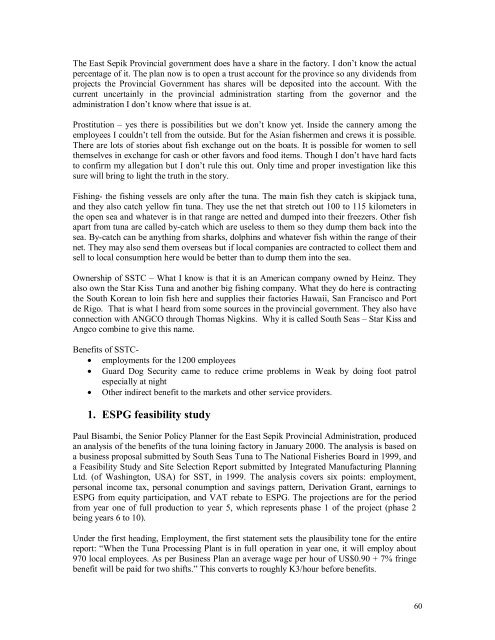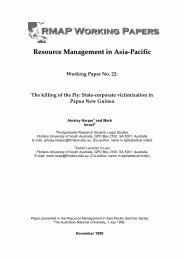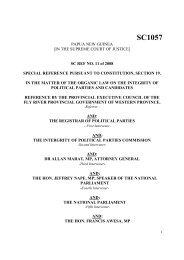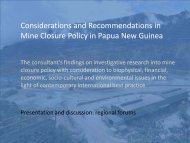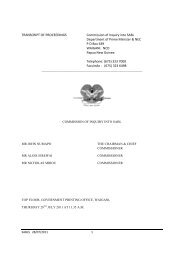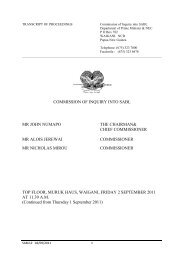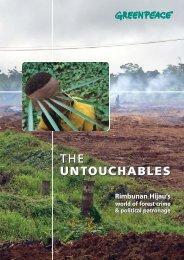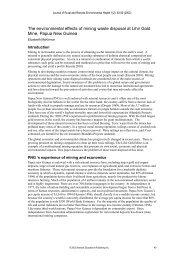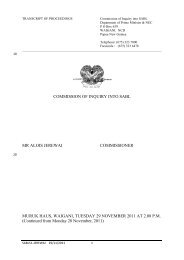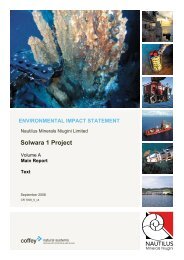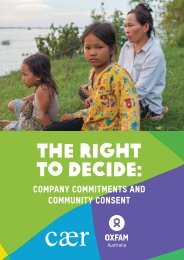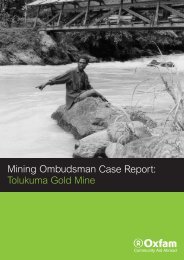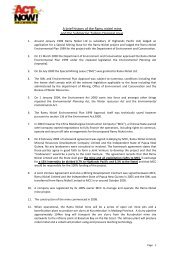<strong>The</strong> East Sepik Provincial government does have a share in the factory. I don’t know the actualpercentage <strong>of</strong> it. <strong>The</strong> plan now is to open a trust account for the province so any dividends fromprojects the Provincial Government has shares will be deposited into the account. With thecurrent uncertainly in the provincial administration starting from the governor and theadministration I don’t know where that issue is at.Prostitution – yes there is possibilities but we don’t know yet. Inside the cannery among theemployees I couldn’t tell from the outside. But for the Asian fishermen and crews it is possible.<strong>The</strong>re are lots <strong>of</strong> stories about fish exchange out on the boats. It is possible for women to sellthemselves in exchange for cash or other favors and food items. Though I don’t have hard factsto confirm my allegation but I don’t rule this out. Only time and proper investigation like thissure will bring to light the truth in the story.Fishing- the fishing vessels are only after the tuna. <strong>The</strong> main fish they catch is skipjack tuna,and they also catch yellow fin tuna. <strong>The</strong>y use the net that stretch out 100 to 115 kilometers inthe open sea and whatever is in that range are netted and dumped into their freezers. Other fishapart from tuna are called by-catch which are useless to them so they dump them back into thesea. By-catch can be anything from sharks, dolphins and whatever fish within the range <strong>of</strong> theirnet. <strong>The</strong>y may also send them overseas but if local companies are contracted to collect them andsell to local consumption here would be better than to dump them into the sea.Ownership <strong>of</strong> <strong>SST</strong>C – What I know is that it is an American company owned by Heinz. <strong>The</strong>yalso own the Star Kiss Tuna and another big fishing company. What they do here is contractingthe South Korean to loin fish here and supplies their factories Hawaii, San Francisco and Portde Rigo. That is what I heard from some sources in the provincial government. <strong>The</strong>y also haveconnection with ANGCO through Thomas Nigkins. Why it is called South Seas – Star Kiss andAngco combine to give this name.Benefits <strong>of</strong> <strong>SST</strong>C-• employments for the 1200 employees• Guard Dog Security came to reduce crime problems in Weak by doing foot patrolespecially at night• Other indirect benefit to the markets and other service providers.1. ESPG feasibility studyPaul Bisambi, the Senior Policy Planner for the East Sepik Provincial Administration, producedan analysis <strong>of</strong> the benefits <strong>of</strong> the tuna loining factory in January 2000. <strong>The</strong> analysis is based ona <strong>business</strong> proposal submitted by South Seas Tuna to <strong>The</strong> National Fisheries Board in 1999, anda Feasibility Study and Site Selection Report submitted by Integrated Manufacturing PlanningLtd. (<strong>of</strong> Washington, USA) for <strong>SST</strong>, in 1999. <strong>The</strong> analysis covers six points: employment,personal income tax, personal conumption and savings pattern, Derivation Grant, earnings toESPG from equity participation, and VAT rebate to ESPG. <strong>The</strong> projections are for the periodfrom year one <strong>of</strong> full production to year 5, which represents phase 1 <strong>of</strong> the project (phase 2being years 6 to 10).Under the first heading, Employment, the first statement sets the plausibility tone for the entirereport: “When the Tuna Processing Plant is in full operation in year one, it will employ about970 local employees. As per Business Plan an average wage per hour <strong>of</strong> US$0.90 + 7% fringebenefit will be paid for two shifts.” This converts to roughly K3/hour before benefits.60
“Based on the 970 local labour requirements for the factory, working two shifts for 8 hours perday for a total <strong>of</strong> ten (10) working days per fortnight, the calculation is worked out to be US$76.80 per local employee per fortnight.” In other words, for someone working 8 hour days, thepay packet would be roughly K256. Presumably, if you took only two weeks <strong>of</strong>f a year, youcould take home K6400 for a year’s labour, which is less than US$2000. And that is if yousurvived double shifts.Wage projection tables show no increase structured for employees in the first five years <strong>of</strong>employment.But an additional K6,028,00 will be injected into the local Wewak economy in year one, and bythe end <strong>of</strong> the fifth year roughly K32,004,000 is to be injected.But if we look at the actual workforce and wage, we can see that the average permanent wage(which only kicks in after 3 months) is K1/hour, which means K40/week or K80/fortnight(before deductions for NPF). (This is roughly US$24/fortnight). This represents an annualincome <strong>of</strong> K2000 (or $US600). Over 1200 employees the amount <strong>of</strong> money being paid out isK2,400,000 (or US$720,000). Given that this is a generous estimate <strong>of</strong> wages (although itdiscludes expatriate salaries, which only partially go back to the Wewak economy), and that asignificant percentage <strong>of</strong> employees are on probationary wages for three months (and more, ifthey drop out and return again), which is half the rate, it is painfully obvious that <strong>SST</strong> is notexactly pumping riches into Wewak. <strong>The</strong> entire workforce earns less than one American CEOmight (one hazards to guess what David Mculley earns).Needless to say, the estimate <strong>of</strong> IRC income from the employee salaries is nothing like theprojected K2,395,000 cumulative taxes estimated to be collected over five years.Even more fantastic are the projections for the Value Added Tax rebates to come to the EastSepik Provincial Government. First, it is assumed that a model wage earner will have adisposable income <strong>of</strong> 70% <strong>of</strong> his/her wage, the other 30% going to personal savings. Whatcountry are we talking about? Surely this model has not been constructed in PNG. With it, Mr.Bisambi projects that K4,220,000 <strong>of</strong> the workers’ total incomes in the first year will be disposed<strong>of</strong> in local shops and service providers. More realistically, the amount would be K1,680,000 perannum IF (and this is a very big if) workers could actually save 30% <strong>of</strong> their earnings. Bisambigoes on to project that 10% <strong>of</strong> this disposable income will actually be spent outside theprovince, leaving an estimated K3,798,000 to be spent in the East Sepik Province. Of this, theESPG would collect roughly K342,000 in VAT rebates, an amount that would be expected torise in the succeeding years.Using our own figures, however, we find that K1,512,000 would be disposable income spent inESP, and 10% <strong>of</strong> this would be K151,200; 90% <strong>of</strong> this latter amount would be garnered by theprovincial government, for a total <strong>of</strong> K136,080. Enough windfall to buy one Land Cruiser.Under the heading ‘Earnings to ESPG from Equity Participation in the Tuna Loining Project’Bisambi notes that ESPG has only expressed interest in participating at that point, and the jointyventure share arrangement at the time was: ANGCO Pty LTd at 50%, FCF <strong>of</strong> Taiwan at 46.9%and Starkist <strong>of</strong> USA at 3.1%. He suggests three scenarios, based on ESPG equity participation<strong>of</strong> 2%, 5% or 10%. Based on an estimated total value <strong>of</strong> export earnings for years two to five, <strong>of</strong>US$47,553,000, the 2% deal would garner the ESPG K2,958,000 in gross earnings; the 5% deal61
- Page 1 and 2:
Fishy BusinessThe social impact of
- Page 3 and 4:
4. Townspeople and market women 158
- Page 6 and 7:
More to the point, the contract for
- Page 8 and 9:
‘development’ projects will be
- Page 10 and 11: whole concept of MSY; the problem o
- Page 12: noted most reasonably that the skil
- Page 16 and 17: • That landowners groups be encou
- Page 18 and 19: This project adopted an open protoc
- Page 20 and 21: public figures who had seen RD Tuna
- Page 22 and 23: suddenly costs the government more
- Page 24 and 25: problems of the poor.’ He pledges
- Page 26 and 27: scores of landowner groups who regi
- Page 28 and 29: areas…There were promises of new
- Page 30 and 31: might say today. This is certainly
- Page 32 and 33: During the 1950’s over 860,000 co
- Page 34 and 35: of reorientation of focus and direc
- Page 36 and 37: But it is the provincial government
- Page 38 and 39: title, sensu the Windjammer, is ‘
- Page 40 and 41: Blue Water Tuna is a private PNG co
- Page 42: 9.5.05: The Bismark Fishing Company
- Page 45 and 46: The two landowning clans of Parom g
- Page 47 and 48: ilong mi na long tingting bilong ol
- Page 49 and 50: ol set ups, say olsem 20 or 30 set
- Page 51 and 52: No contact or awareness with Marien
- Page 53 and 54: Los Angeles, CA 90021USATel: 1-800-
- Page 55 and 56: meters out from its original size,
- Page 57 and 58: The Offshore Masters is going to be
- Page 59: I am not aware of any Environmental
- Page 63 and 64: Water Resources Act (Chapter No. 20
- Page 65 and 66: The 26 Local Level Governments in t
- Page 67 and 68: people were made to believe that ne
- Page 69 and 70: Nianguma, so the leaders of the 8 c
- Page 71 and 72: 3. That there was a totally unbeara
- Page 73 and 74: p10:p12:73
- Page 75 and 76: p.14:75
- Page 77 and 78: . Marine Ripples articleThe followi
- Page 79 and 80: In general, I feel SSTC has present
- Page 81 and 82: •how the tuna factory development
- Page 83 and 84: Responses to Consent Condition Exce
- Page 85 and 86: “Sometimes while working we are t
- Page 87 and 88: fisheries myself at one stage and f
- Page 89 and 90: N: “Have you sponsored sporting g
- Page 91 and 92: never cleaned fish before, that was
- Page 93 and 94: IB: “Oh sure, but somebody’s go
- Page 95 and 96: Philomena Naura: “The smell aroun
- Page 97 and 98: There is no covering to the oxidizi
- Page 99 and 100: Above: four consecutive pay slips f
- Page 101 and 102: Above is a list of curses said to b
- Page 103 and 104: duties on one of the ships offloadi
- Page 105 and 106: on the side of the fishing vessel.
- Page 107 and 108: The fishery observer told us that i
- Page 109 and 110: Speaking of prostitution on fishing
- Page 111 and 112:
and if any major disruptions occur
- Page 113 and 114:
Most of us here are very unfortunat
- Page 115 and 116:
The husband of the woman employed a
- Page 117 and 118:
Thomas Nigints was one of the few p
- Page 119 and 120:
Did SST place FADs in the sea?The c
- Page 121 and 122:
doing it, it’s going to be over o
- Page 123 and 124:
Landowners are also deeply disturbe
- Page 125 and 126:
places or settlement where they are
- Page 127 and 128:
in the revenue, so when the opportu
- Page 129 and 130:
And as soon as they’d finished th
- Page 131 and 132:
There is no legal case as yet with
- Page 133 and 134:
owns the land legally and therefore
- Page 135 and 136:
There is still need to recruit more
- Page 137 and 138:
In regard to the production, by the
- Page 139 and 140:
The company invited interested peop
- Page 141 and 142:
strategy is very well used by forei
- Page 143 and 144:
employees and those whose work requ
- Page 145 and 146:
The present Human Resource Manager
- Page 147 and 148:
working gear? In my section I wear
- Page 149 and 150:
working for a whole first week with
- Page 151 and 152:
Serah from Manam island, married wi
- Page 153 and 154:
stret long mipela ol mama husait I
- Page 155 and 156:
The supervisors in the plant/engine
- Page 157 and 158:
The color of the sea has changed. F
- Page 159 and 160:
Donald Jacob, Catrans fuel distribu
- Page 161 and 162:
Kapmandu Service station. Did South
- Page 163 and 164:
Three women involved with roadside
- Page 165 and 166:
export processing zones and then in
- Page 167 and 168:
When we asked if this meant sportin
- Page 169 and 170:
then men’s. Usually they’re exc
- Page 171 and 172:
The WWF consultant also notes that
- Page 173 and 174:
of a company like SST cannot be pla
- Page 175 and 176:
East Sepik Governor Arthur Somare s
- Page 177 and 178:
The cost of the project is between
- Page 179 and 180:
The National Shipping Page, 1.6.04W
- Page 181 and 182:
that have similar fish factory set-
- Page 183 and 184:
Infofish website : PNG: Tuna export
- Page 185 and 186:
Post-Courier 20.6.05185
- Page 187 and 188:
Did your application form ask you a
- Page 189 and 190:
Do you know whether the Provincial
- Page 191 and 192:
The Provincial AdministratorDept. o
- Page 193 and 194:
4. Human Resources registerees, Kew
- Page 195 and 196:
195
- Page 197 and 198:
Under Spin-Off Business Activities
- Page 199 and 200:
Finally, Honourable Ministers, Memb
- Page 201 and 202:
The adverse non-immune (toxic) and
- Page 203 and 204:
low income) will have an impact in
- Page 205 and 206:
ed and pink plastic roses are every
- Page 207 and 208:
207
- Page 209 and 210:
Tuna fisheriesThe management system
- Page 211 and 212:
• Monitor interactions between th
- Page 213 and 214:
Programme is expanding this program
- Page 215 and 216:
This office recommends that, since
- Page 217 and 218:
commercial industry still deny any
- Page 219 and 220:
219
- Page 221 and 222:
221
- Page 223 and 224:
REPORTER: If you come and you put t
- Page 225 and 226:
Berman, M. 1997. Faust, the First D
- Page 227 and 228:
Lutkehaus, N., C. Kaufman, W.E. Mit


